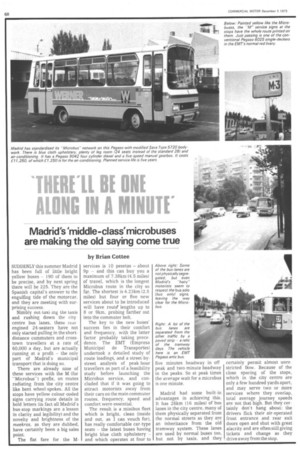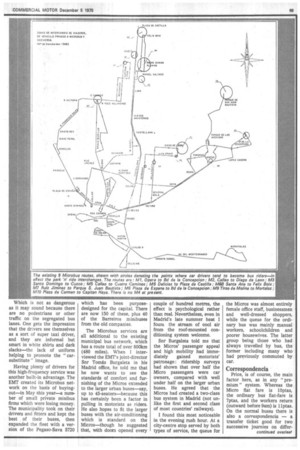'THERE'LL BE ONE ALONG IN A MINUF
Page 72

Page 73

Page 74

If you've noticed an error in this article please click here to report it so we can fix it.
Madrid's 'middle -class' microbuses are making the old saying come true
by Brian Cottee
SUDDENLY this summer Madrid has been full of little bright yellow buses 190 of them to be precise, and by next spring there will be 225. They are the Spanish capital's answer to the engulfing tide of the motorcar, and they are meeting with surprising succ-ess.
Nimbly out-taxi-ing the taxis and rushing down the citycentre bus lanes, these rear• engined 24-seaters have not only started pulling in the shortdistance commuters and crosstown travellers at a rate of, 60,000 a day, but are actually running at a profit the only part of Madrid's municipal transport that is doing so.
There are already nine of these services with the M (for "Microbus" ) prefix, on routes radiating from the city centre like bent wheel-spokes. All the stops have yellow colour-ooded signs carrying route details in bold letters (in fact all Madrid's bus-stop markings are a lesson in clarity and legibility) and the novelty and brightness of the meekros, as they are dubbed, have certainly been a big sales point.
The flat fare for the M services is 10 pesetas about 9p and this can buy you a maximum of 7.38km (4.5 miles) of travel, which is the longest Microbus route in the city so far. The shortest is 4.23km (2.5 miles) but four or five new services about to be introduced will have route lengths up to 8 or 9km, probing farther out into the commuter belt.
The key to the new buses' success lies in their comfort and frequency, with the latter factor probably taking precedence. The EMT (Empresa Municipal de Transportes) undertook a detailed study of route loadings, and a street-bystreet analysis of peak-hour travellers as part of a feasibility study before launching the Microbus service, and concluded that if it was going to attract motorists away from their cars on the main commuter routes, frequency, speed and comfort were essential.
The result is a minibus fleet which is bright, clean (inside and out, as I can vouch for), has really comfortable car-type seats the latest buses having bright blue cloth upholstery and which operates at four to Madrid had some built-in advantages in achieving this. It has 26km (16 miles) of bus lanes in the city centre, many of them physically separated from the normal streets as they are an inheritance from the old tramway system. These lanes are used by normal buses too, but not by taxis, and they certainly permit almost unrestricted flow. Because of the close spacing of the stops, which in the city centre are only a few hundred yards apart, and may serve two or more services where they overlap, total average journey speeds are not that high. But they certainly don't hang about: the drivers flick their air-operated front entrance and rear exit doors open and shut with great alacrity and are often still giving tickets and change as they drive away from the stop.
Which is not as dangerous as it may sound because there are no pedestrians or other traffic on the segregated bus lanes. One gets the impression that the drivers see themselves as a sort of super taxi driver, and they are informal but smart in white shirts and dark slacks—the lack of uniform helping to promote the " carsubstitute " image.
Having plenty of drivers for this high-frequency service was another built-in advantage, The EMT created its Microbus network on the basis of buyingout—in May this year—a number of small private minibus firms which were losing money. The municipality took on their drivers and fitters and kept the best of their buses, then expanded the fleet with a version of the Pegaso-Sava 5720 which has been purposedesigned for the capital. There are now 150 of these, plus 40 of the Barreiros minibuses from the old companies.
The Microbus services are all additional to the existing municipal bus network, which has a route total of over 800km (480 miles). When I interviewed the EMT's joint-director Snr Tomas Burgaleta in his Madrid office, he told me that he now wants to see the standards of comfort and furnishing of the Micros extended to the larger urban buses—say, up to 45-seaters—because this has certainly been a factor in pulling in motorists as riders. He also hopes to fit the larger buses with the air-conditioning which is standard on the Micros—though he suggested that, with doors opened every couple of hundred metres, the effect is psychological rather than real. Nevertheless, even in Madrid's late summer heat I fount the stream of cool air from the roof-mounted conditioning system welcome.
Snr Burgaleta told me that the Micros' passenger appeal and high mobility had immediately gained motorists' patronage: ridership surveys had shown that over half the Micro passengers were car owners, compared with well under half on the larger urban buses. He agreed that the Micros had created a two-class bus system in Madrid (not unlike the first and second class of most countries' railways).
I found this most noticeable in the evening rush hour. At a city-centre stop served by both types of service, the queue for the Micros was almost entirely female office staff, businessmen and well-dressed shoppers, while the queue for the ordinary bus was mainly manual workers, schoolchildren and poorer housewives. The latter group being those who had always travelled by bus, the former including many who had previously commuted by car.
Correspondencia
Price, is of course, the main factor here, as in any " premium " system. Whereas the Micro flat fare is lOptas, the ordinary bus flat-fare is 7ptas, and the workers return (outward before 9am) is 1 lptas. On the normal buses there is also a correspondencia — a transfer ticket good for two successive journies on differ ent buses, for lOptas. On the ordinary buses there is a special night flat-rate of 8ptas after 1 lpm (and incidentally a special night service which, from midnight, takes people home from the city centre to the suburbs.) Regular travellers can buy multi-journey Microbus tickets at a discount, but the predominance of the use of workers' returns on normal services is revealed by the fact that the average fare paid over all Madrid's bus services works out at 6.5ptas.
The only individual normalbus service to equal the Micros' 60,000 passengers a day is the circular service, which runs continuously in both directions around the perimeter of the city centre. It was started only four years ago.
As Snr Burgaleta demonstrated to me, EMT runs its whole day-to-day operation on the information provided by rapid computer print-outs. By Sam he and his staff have a summary of the previous day's traffic and takings, line by line, and this is followed within a , few days by a more accurate and detailed summary. But, he said, the rapid print-out is seldom more than 0.1 per cent adrift, and it is used to identify and tackle problems and to make service alterations.
The information is based on depot routines which are meticulously adhered to. Each depot has its own security office, or "bank," which takes in the money from the lines it serves. During the night this office calculates each line's passengers and takings and phones them to headquarters.
Six to seven days later there follows a final centralised print-out, which compares that day's results with the previous day, and the same day in the previous week and in the previous year. It covers, for each service, the passengers carried, money taken, number of buses on service and out of service, scheduled vehicles for the day, service mileage, dead mileage, average service speed, passengers per mile, pesetas per passenger, number and type of tickets sold and so on.
This, and a monthly operating summary which highlights the utilisation of each class of bus and the number of passengers and revenue per line, are used as the main operational planning documents.
Surface transport in Madrid carries 550m passengers a year, of which the EMT share is 430m and the rest mainly travel on the small privately owned services on the outskirts. There are 11 of these, with 17 lines, and EMT plans to buy them Out eventually. The Metro carries about 500m people annually.
The disappearance of Madrid's trams in 1968-70 was, said Snr Burgaleta, largely because there was no Spanish company which made or maintained the traction motors and other specialised equipment. But they were in any case becoming outdated, and would shortly be followed by some of the articulated buses because falling public transport patronage—until the arrival of the Micro—had made the highcapacity vehicle under-utilised. On all but three services the peak-hour loadings could be coped with, and at better frequency, by normal singledeckers, of which there are 1,275 in the fleet ; 400 of these are one-man front-entrance types, the rest two-man, rearentrance with seated conductor. Madrid has 85 one-man artic buses and 90 two-man artics, but only 89 are still in regular Service. No more are being bought.
All these buses are Pegasos, and the Pegaso-Sava will be the standard Microbus. The total EMT fleet is around 1,700 vehicles, housed in four suburban depots and a large depot and maintenance workshop in North Central Madrid — there are 400 vehicles here.
The EMT has vehicle-life policies which would make most British bus operators green with envy — especially just now. The present average vehicle life is 4.1 years, though this is distorted by a recent influx of new vehicles. Still, the oldest bus in the fleet is nine years old, and two years ago the average life was nine years. Three years ago it was 12 years — and the objective is a five-year life across the fleet, including the Micros.
Snr Burgaleta said that all their experience showed how costly it was to run old vehicles. It paid in hard cash as well as passenger appeal to replace frequently ; where they had done this, they had seen service and repair costs — and especially labour costs — fall like a stone.
Buses are much more expensive in Spain than in the UK, and EMT has to finance its own capital programme. About 65 per cent of the loans for new vehicles purchase comes from private banks (at 6 to 7 per cent interest) and the rest are local authority loans.
Labour costs are the highest single item and the policy objective is to reduce the numbers, by wastage, to four employees per vehicle (it was seven a few years back). EMT at present employs 6,895 people.
Like every large city in the world, Madrid has to subsidise its public transport — but, against the trend, the rate of increase of the deficit is slowing. In 1974 the support from the municipal rates was 228m ptas (£1.9m), though total costs were 2,626m ptas (£22m).
The success of the Micros has certainly given EMT an Optimistic air, and it is trying some more new bus services— though on a smaller scale. For instance, a "green circuit" linking the city's 15 parks and a " blue circuit' linking 13 art galleries and museums.
But Snr Burgaleta and his colleagues obviously see the main line of development in extending the Micro serviced and in gradually spreading the standards of comfort up the size scale — which is made easier by the policy of short vehicle life.
Whether there is a place for something like the Micro in other congested cities — not least in Britain — is the 64,000dollar question. But in Madrid during the recent ECMT conference I met a London Transport man riding a Micro and noting the details, and these little vehicles were quite a talking point among bus managers and transport civil servants from many European countries,


































































































































